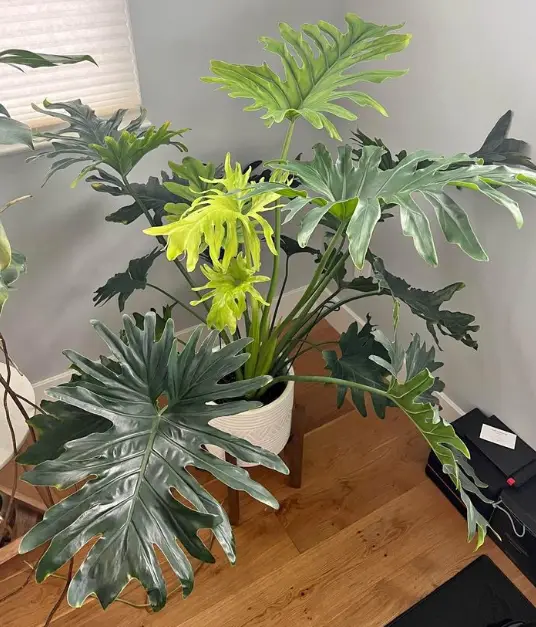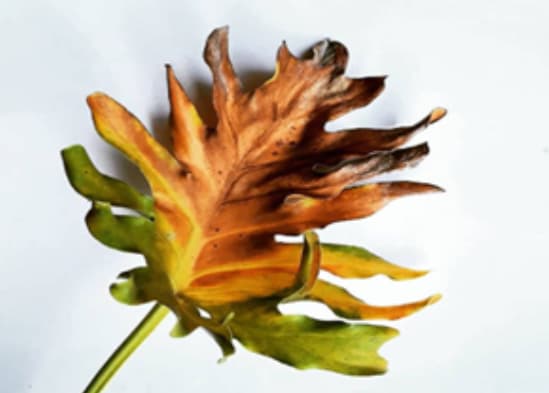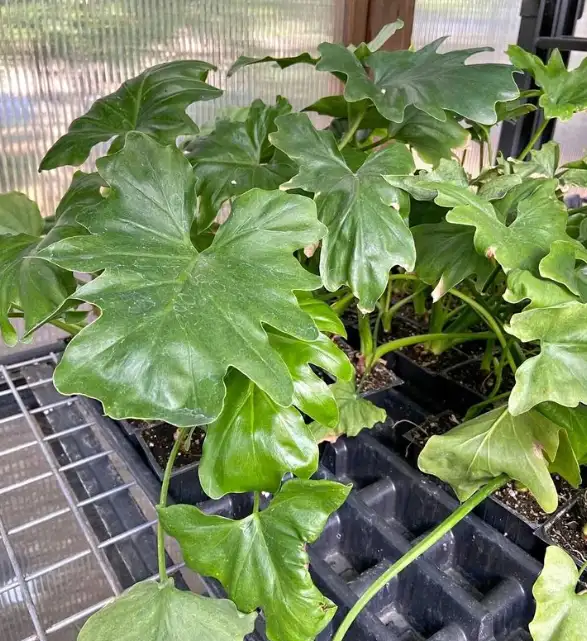Why are Philodendron Selloum Leaves Turning Yellow? [!Solved Finally]
Are you worried about your Philodendron Selloum leaves turning yellow? Don’t worry about it. We have solutions for you.
Plants with rich green leaves increase the beauty of a house and brighten your day. But sometimes, plant leaves turn yellow even after giving too much effort. It is quite frustrating when you have given much effort but the plant’s leaves turn yellow. The good news is that yellow leaves indicate that they need help.
Selloum plant is turning yellow because of the conditions of the soil moisture, nutrient deficiency or poor lighting condition. Mostly leaf yellowing on Selloum plants occurs because of over or underwatering. If there is seen yellow and brown combination on the same leaves then it is because of overwatering. And if you can see that leaves become yellow and have crispy spots on the leaf surface then it is supposed to be underwatering.
Leaves yellowing on Philodendron Selloum houseplants can be caused by several conditions. When you see that your leaves are turning yellow, it’s time to be concerned about your plants and do some sleuthing to find the possible causes and their solutions. In this article, we will discuss the causes and solutions of leaves yellowing. By taking the right steps, you can cure yellow leaves and prevent their return.
Philodendron is a tropical plant that has large, showy leaves. This is mostly grown as houseplants in a temperate climate. A Philodendron Selloum is a variety of Philodendrons which is also known as tree Philodendron. It has dark green, shiny leaves which are large and deeply lobed and the stem color is green.
General Overview of Philodendron Selloum
| Common Name | Tree Philodendron |
| Origin | South America |
| Family | Araceae |
| Height | 6 to 10 feet |
| Spread | 6 to 8 feet |
| Plant type | Shrub |
| Flower | White, spadix inflorescence |
| Toxicity | Toxic for human and pet |
Philodendron Selloum is one of the most popular houseplants. Its dramatic look increases the beauty of the house. But sometimes, there can be arisen leaf discoloration problem.
There can be some other reasons behind your Selloum leaves turning yellow. In this article, we will investigate and go through some possible reasons why Selloum leaves turn yellow and give you some solutions which help you enough to improve your plant. Hope so in the end you can cure the problem easily.
Why are my Philodendron Selloum Leaves Turning Yellow?

Moisture Stress or Improper Watering
Yellowing plants may often be a sign of overwatering or underwatering. Most commonly the leaf yellowing problem among Philodendron Selloum is caused by improper soil moisture, particularly overwatering.
In the over wet soil, roots cannot breathe, they suffocate and stop delivering water and nutrients to the other parts of the plant which is needed by the plant. Also underwatering has a similar effect. If plants get too little water, they can’t take up essential nutrients and as a result, leaves turn yellow.
Plants start to drop leaves if they don’t get enough water. They prevent transpiration to conserve water. The leaves typically turn yellow before they drop.
When the soil doesn’t drain well, it can be the cause of soil waterlogged and that’s why root systems can literally drown. Roots start to die because of the lacking of oxygen.
Also, ill-timed watering can cause the Selloum to yellow because it creates stress to the plant. So providing proper and consistent soil moisture is important in caring for the Philodendron Selloum plant.
Solution
Plants don’t have facial expressions. So they cannot express their discomfort or displeasure. They can only show their dissatisfaction by signaling with their leaves. So, when you notice that your Selloum leaves becoming yellow you should start nursing your unsound Selloum plant.
When you can see that the top 20% of soil is dry in the pot then water your Selloum. Soil should not remain wet but it should remain damp.
Provide adequate water to your plant. Water should have flowed into the saucer from the drainage hole. It is very important to discard excess water so that plant doesn’t stay in standing water.
If it stays in wet feet it will not respond well and it can be the cause of root rot and the eventual death of the plant.
There is a very easiest method to know about whether the plant needs watering. And the method is the ‘finger test method’. You can use this method before watering. Give a finger into the soil and if it is hard to enter the finger into the soil then it needs watering. If you feel the soil is wet and cool then it doesn’t need watering at that moment.
You can also test your soil moisture by using a screwdriver test. If a screwdriver gets into the soil easily then it doesn’t need watering right now but if it is hard to push in then you should understand that the plant is thirsty and need deep watering.
Soil should be allowed to dry a little bit before watering your Selloum plant again. Mostly, Philodendron requires watering 1-2 times a week.
Humidity Level
Philodendron Selloum has thinner leaves than many other plants of Philodendron which are relative. So it needs a more humid environment for the good growth of the plant. Leaves start turning yellow or brown on their edges and droop because of low humidity and dry soil.
Solution
The best way to increase the humidity is by misting the leaves of the Philodendron Selloum. If there is a very dry environment in the season of winter then you can place your Selloum plant close to a humidifier to keep the humid level above.
Lack of Light
Philodendron Selloum requires bright indirect light or a medium level of sunlight to grow. Lower light or too much light can be the cause of changing the leaves’ color.
Lower light changes the leaf color to a darker green and too much light distress the leaves and it causes the leaf color turning to fade green from deep green color.

This plant grows best in bright indirect sunlight. But when it is exposed to direct sunlight for a long time then the foliage will burn and turn yellow.
When it is adapted to low light then its growth will slow and if it is placed in very low light, yellow leaves will develop.
Mostly The damage is seen on the leaf surface in constant contact with the sunrays. Turning yellow leaves also can occur if the Selloum plant is placed near the AC, heating vent, etc. Too much or too little light can create the inability of the plant to photosynthesize properly.
Solution
The leaves are yellowing from the lack of light, typically they are on the side which is away from the light source. They are blocked by the leaves which are near to the window.
The window side leaves get all the light and block the opposite side. So an easy and great way to remedy this problem is to turn the pot a bit once a week so that all sides of the plant have access to natural light.
Also, you can move the plant to a sunnier location if window light is tough to come by in your home. Especially in the winter, it is tough to get enough light through the window. So you can also use an artificial plant light or two.
If the pant leaves are getting yellow because of excess sunlight then you should move away from your Selloum from the direct sunlight. Also, you can use blinds on your windows to regulate the amount of sunlight reaching your plants.
Philodendron Selloum can tolerate low light conditions. They don’t require much sunlight for growing well; they prefer medium-light to bright indirect sunlight. So, here you have plenty of options on where you think is the best to place your plant.
Nutrient Deficiency
Your beautiful Philodendron Selloum may also turn yellow because of the deficiency of nutrients. Maybe it is not receiving all of the nutrients properly. Yellowing leaves are a sign of chlorosis that is caused by iron and magnesium deficiency. Other minerals like zinc, calcium are also necessary for a healthy plant.

Also, yellow leaves happen because of nitrogen deficiency. This is very mobile. Nitrogen moves through the soil easily and leaches away. This turns the plant leaves yellow or pale green.
Because of nutrient deficiencies, the plant’s top leaves may be the first to go yellow. An unnatural pattern may be noticed in the yellowing. There is seen the veins remaining dark but the tissues turn yellow. The problem of yellowing on the Selloum plant can be caused by the following nutrient deficiencies:
- Nitrogen deficiency – a general yellowing is seen when there is nitrogen deficiency. Older, inner leaves are seen turning yellow first. And progressively yellowing moves outward.
- Magnesium deficiency – if the plant is suffering from magnesium deficiency then there is noticed V-shaped yellow spots on its leaf surface. This problem is relatively easy to correct.
- Iron deficiency – it is shown on the plant’s top young leaves and branch tips first. It also shows as yellowing between leaf veins.
Solution
The solution for nutrient deficiency is feeding the plant with fertilizer. A nutritious potting medium can prevent your plant from turning yellow and promotes plant health.
At first, to fix iron deficiency you should feed your Selloum plant with an iron supplement such as Ironite. Iron deficiency is causing leaf chlorosis.
Also, for fixing magnesium deficiency, add magnesium to the soil. Mix 1 teaspoon of magnesium sulfate or Epsom salts per 1 gallon of water and enrich the soil with it.
The second step you can do is to remove the plant from the existing pot and replant it with a new, more fertile potting mix. In this process, you have to be careful not to damage the roots.
You can also fix your plant’s nutrient deficiency by adding fertilizer to the soil. There is a proper way to add fertilizer to your plant.
For identifying the missing nutrients for those plant leaves that are turning yellow, take a sample of the soil and test in the lab. Also, you can purchase a small soil kit for an at-home soil test. Then purchase the fertilizer with the recommended nutrients and mix it with the soil.
Improper Soil pH
If plants are getting proper fertilizer then soil pH isn’t the cause of leaf yellowing. Soil pH influences whether plants access nutrients.
But if leaf problem centers on landscape plants then soil pH may be the key.
Nutrient availability changes because of the ups and downs of soil pH. When soil pH turns higher or lower from the optimal level, there is lacking some nutrients. Even if the nutrients exist, they cannot be taken by the plants.
Because of the improper soil pH, the plant cannot take the essential nutrients even from the fertilizers you add. As a result, Selloum leaves seem to turn yellow.
Solution
You can identify your soil pH by an easy soil test and can fix this problem. A soil test also provides much other necessary information which helps to fix the problem.
Some recommendations are also given by most testing labs for soil care for restoring the pH balance of the soil. It can help the plant as the plant gets its nutrients and green leaf back.

Viral Infection
Sometimes spreading yellow patches on leaves throughout the plants is caused by viral infection. It is the cause of discoloring the leaves and stems.
Philodendron Selloum as well as all Philodendron are solid and hardy plants that can survive in different conditions and require low maintenance. But if there is a fungal infection then it can damage the roots and therefore root rot is seen in the plant.
It affects the plant’s ability to absorb water and nutrients; as a result, leaves yellowing to occur.
Solution
Viral infection may not be cured and it can infect all susceptible plants nearby. So the best way to fix yellow Selloum leaves is to change the potting mix and quarantine the infected plant from the rest of the plants.
At first, you have to identify the virus, and then you can take steps to save the plants.
The first step you can take is soaking the soil in water and gently tap on the sides of the potting container. Properly wash the plant’s roots and remove the unhealthy, black, rotten part. Then transplant your Selloum on a sanitized pot.
When repotting you must prune off any infected roots that are beyond saving and must wash and sterilize any pruning tools or pots before using them on other plants.
Cold Draft
The leaves also turn yellow because of cool drafts on tropical plants. It causes browning of the leaf, spots that are transparent between veins, and dropping of the leaves.
If your Selloum plant is close to the vent of the air conditioner in the summer season or an ill-fitting window in the winter season for a long time then it causes the leaves to turn yellow.
Solution
Move your Selloum plant from the nearest place of the air conditioner to an orderly place. And always keep noticing on the plant to see whether the yellow leaves expand any further.
Also misting is a very useful idea that you’re overwintering to increase the humidity.
Normal Aging
Yellowing also can occur because of aging. As many plants age, the lower leaves of the plants turn yellow and drop off. But it is a normal part of their growth.
If your Selloum plant is very old then yellow leaves can be seen as they are aged. There is new growth on your plant and the yellow leaves are older. The plant sheds the new leaves and sends energy to the new growth and that’s why the older leaves become yellow.
Solution
In this case, you don’t need to worry about your favorite Selloum plant. There is no other deficiency behind the discoloration of the leaves. If your Selloum plant becomes too long then you can cut the stem and create a new one by propagating your philodendron selloum.
Why Selloum Plant Leaves are Turning Yellow in Containers?

Philodendron Selloum is a popular houseplant. There is surrounded environment when the plant is grown indoor in the containers. So there are some conditions which must be controlled carefully.
There is a fixed amount of space, light, area for storing moisture and nutrients in the container. Also, you must consider the temperature for each species of a potted plant. That’s why sometimes there exists some deficiency and plant’s leaves become yellow.
Leaves yellowing in Selloum plants often occurs because of excess amount of salt and nutrient deficiency in the existing soil from excessive use of fertilizer. It is quite necessary to change the soil to correct the balance or leach it with an adequate amount of water. But sometimes it can cause leave yellowing problem and also dropping leaves.
Also, soil pH may be too high because of growing the plant into a container. This is also the cause of yellowing leaves. Using a pH meter is a good idea to ensure the correct growing conditions.
When Plant Leaves are Yellow from Pests or Disease?
It is quite difficult to pinpoint the causes of yellowing leaves due to all the potential causes. But one thing we haven’t gone over is pests and disease.
An aged, weak, and stressed Selloum is often infected by insects. They are more able to insect infections. These pest attacks might cause the leaves to turn yellow.
Spots of discoloration on the plant are an indication of pest damage. Some pests such as aphids attach themselves on the sensitive surface of the leaves such as under the leaves and stem to feed on the plant’s sap. They can absorb the moisture of your plant.
Insects are too tiny to see and identify. So in most cases, you should rapidly wash your plant to remove the insects. You can also use the horticultural soap or neem oil to combat these little pirates.
Final Thought
As you can see there are many causes for yellowing your lovely Selloum plant leaves. It will be best if the plant’s exact needs are familiar to you then you can handle each problem carefully and cure the problem as soon as possible.
You don’t need to worry too much if your Selloum leaves turn yellow. You can prevent the yellowing through regular maintenance and observation.
I hope, the causes and solutions discussed above will help you enough to prevent your beautiful Selloum plant from yellowing and damaging. It will provide you enough information to identify the cause, how it occurs, and fix it.

![Philodendron Brasil Leaves Turning Yellow- [!SOLUTIONS & CAUSES]]](https://diaryforgardening.com/wp-content/uploads/2021/12/Philodendron-Brasil-Leaves-Turning-Yellow.jpg)
![How to make Philodendron Xanadu bushy? [Create your little jungle]](https://diaryforgardening.com/wp-content/uploads/2022/05/How-to-make-xanadu-bushy.jpg)
![Philodendron brasil light requirement – [Detailed Guide]](https://diaryforgardening.com/wp-content/uploads/2022/05/Philodendron-brasil-light-requirement.jpg)
![Difference between Hoya Krimson Queen vs Princess [Identify correctly]](https://diaryforgardening.com/wp-content/uploads/2021/01/Hoya-krimson-queen-vs-princess.jpg)
![Philodendron florida beauty vs florida ghost [Differences & similarities to identity ]](https://diaryforgardening.com/wp-content/uploads/2022/09/Florida-beauty-vs-ghost.webp)
![Can jade grow in water? [3 Things you should know]](https://diaryforgardening.com/wp-content/uploads/2022/04/Can-Jade-Grow-in-Water.jpg)
